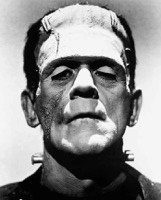Monster
Origin
Middle English monstre, from Anglo-French, from Latin monstrum omen, monster, from monēre to warn
The root of "monstrum" is "monere"—which does not only mean to warn, but also to instruct, and forms the basis of the modern English demonstrate. Thus, the monster is also a sign or instruction. This benign interpretation was proposed by Saint Augustine, who did not see the monster as inherently evil, but as part of the natural design of the world, a kind-of deliberate category error.
Definitions
- b : one unusually large for its kind
- 4: something monstrous; especially : a person of unnatural or extreme ugliness, deformity, wickedness, or cruelty
- 5: one that is highly successful
Description
A monster is any creature, usually found in legends or horror fiction, that is often hideous and may produce fear or physical harm by its appearance and/or its actions. The word "monster" derives from Latin monstrum, an aberrant occurrence, usually biological, that was taken as a sign that something was wrong within the natural order.
The word usually connotes something wrong or evil; a monster is generally morally objectionable, physically or psychologically hideous, and/or a freak of nature. It can also be applied figuratively to a person with similar characteristics like a greedy person or a person who does horrible things.
Among newborn young and embryos of humans and most species of animals are found occasional individuals who are malformed in whole or in part (cf. Teratology). The most grossly abnormal of these have been referred to from ancient times as monsters, probably because the birth of one was thought to signify something monstrous or portentous; while the less severe are known as abnormalities or anomalies or even birth defects. No sharp line separates these grades of malformation, all being due to various kinds and degrees of modification of the normal course of development of the embryo. The study of these deviations forms the subject of teratology, a branch of morphology or embryology.
A knowledge of the kinds of abnormalities and their causes may, like deliberate experiments, increase understanding of normal development. Convention recognizes two major classes of monsters: those that represent defective or excessive growth in a single body, and those that have partial or complete doubling of the body or one of its axes. Otherwise, classic monsters spawn from legends and fictional stories. Well known monsters include Dracula, Frankenstein's creation, Wolf-man, The Mummy, The Invisible Man and zombies, to name a few.[1]
